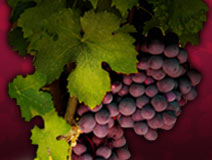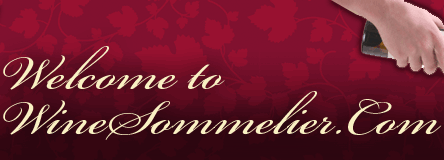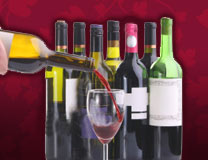Grape Types and their
Characteristics in White Wines:
Chardonnay
| • |
Use in Old World- Burgundy |
| • |
Use in New World- Pervasive |
| • |
Color- Almost always tends toward light golden hues. |
| • |
Aroma- Tropical fruits, melons, mineral qualities, citrus and even green apple are all comon. |
| • |
Body- Medium to Heavy |
| • |
Wine Making Flavors- Heavy use of oak, but incorporates well into the wine. |
| • |
Blended with: Rarely, but occasionally of late with Sémillon. |
| • |
Other- Increasingly being planted in Italy where it only recently received official status. |
Riesling
| • |
Use in Old World- Germany, Alsace |
| • |
Use in New World- US, New Zealand |
| • |
Color- Almost always clear, becoming golden with age. |
| • |
Aroma- Flowery with a distinct aroma often called "petrol" or "diesel". |
| • |
Body- Light to Medium |
| • |
Wine Making Flavors- Occasional light oak. Often made sweet. |
| • |
Blended with: With Ruländer (Pinot Gris) but never in quality wines. |
| • |
Other- Another great grape that doesn't get the respect it deserves. Many examples, either dry or sweet, are among the finest, most complex wines in the world. |
SEmillon
| • |
Use in Old World- Bordeaux |
| • |
Use in New World- Australia primarily. Can be found in small plantings around the world. |
| • |
Color- Very light golden to clear. |
| • |
Aroma- Figs and or orange marmalade is the traditional answer. I tend to find a rubbery smell on occasion. |
| • |
Body- Moderate |
| • |
Wine Making Flavors- Generally not many flavors other than the fruit. The exception is when it is botrytis affected to make Sauternes style sweet wines. |
| • |
Blended with: Usually with Sauvignon Blanc. Occasionally with Chardonnay. |
| • |
Other- Widely planted, but rarely respected. A shame. |
Sauvignon Blanc
| • |
Use in Old World- Bordeaux and the Loire. |
| • |
Use in New World- Pervasive. |
| • |
Color- Usually clear. |
| • |
Aroma- Fresh cut grass is most common. Grapefruit is another style. |
| • |
Body- Light to medium. |
| • |
Wine Making Flavors- Some oak, but rarely strong. |
| • |
Blended with: In Bordeaux almost always with Sémillon. |
| • |
Other- Very common variety. Can be an excellent food wine. |
Chenin Blanc
| • |
Use in Old World- Loire (Anjou) |
| • |
Use in New World- US and South Africa. |
| • |
Color- Clear. |
| • |
Aroma- Green apples. Occasionally honeyed. |
| • |
Body- Light. |
| • |
Wine Making Flavors- Minimal flavors intrude, even when much is done to the wine. |
| • |
Blended with: Almost never, except in bulk wines, when it is blended with other bulk varieties. |
| • |
Other- By far the most misunderstood white variety. In the Anjou region of the Loire in France, it makes remarkable wines, the best of which (Coteaux du Layon) are lightly sweet and among the most long lived. In the rest of the world it is used for cheap whites and jug wine. |
Pinot Gris
| • |
Use in Old World- Germany (Ruländer), Alsace, France (Tokay d'Alsace), Italy (Pinot Grigio), Eastern Europe. |
| • |
Use in New World- Rare but increasing. |
| • |
Color- Clear, occasionally it has a pink tinge |
| • |
Aroma- Somewhat nondescript spicy fruit. |
| • |
Body- Light |
| • |
Wine Making Flavors- Rare |
| • |
Blended with: Rare. |
| • |
Other- A degenerative clone of Pinot Noir. |
Pinot Blanc
| • |
Use in Old World- Alsace, Burgundy (disapearing rapidly) and Germany. |
| • |
Use in New World- Some US |
| • |
Color- Clear to light golden. |
| • |
Aroma- Crisp and clean, little aroma |
| • |
Body- Light to Medium. |
| • |
Wine Making Flavors- Can be heavily oaked, especially in the US. In Alsace it is kept clean and crisp. Often used to make sparkling wine. |
| • |
Blended with: Rarely, although occasionally with Chardonnay. |
| • |
Other- From Pinot Noir (black), to Pinot Gris (grey) to Pinot Blanc (white). |
GewUrztraminer
| • |
Use in Old World- Alsace, France and Germany. |
| • |
Use in New World- US. |
| • |
Color- Clear |
| • |
Aroma- Intense aroma, referred to as spicy. |
| • |
Body- Light to Medium. |
| • |
Wine Making Flavors- Often (except Alsace) made sweet. |
| • |
Blended with: None |
| • |
Other- A wonderfully intense wine. The best examples are by far and away from Alsace where they are dry. |
Viognier
| • |
Use in Old World- Rhône |
| • |
Use in New World- Increasingly in California |
| • |
Color- Clear to yellow straw. |
| • |
Aroma- Orange blossom and peaches. Always intense |
| • |
Body- From very light to medium. |
| • |
Wine Making Flavors- Rare |
| • |
Blended with: Syrah, the red grape, to make Côte Rôtie. |
| • |
Other- It has become popular in the last few years. |
Trebianno / Ugni Blanc
| • |
Use in Old World- Cognac (St-Emilion), Italy. |
| • |
Use in New World- Increasing, especially in Australia. |
| • |
Color- Clear. |
| • |
Aroma- Thin |
| • |
Body- Light. |
| • |
Wine Making Flavors- Rare. |
| • |
Blended with: None |
| • |
Other- The "world's most prolific wine producer." It is downright ubiquitous in Italy. |
Malvasi
| • |
Use in Old World- Italy and Rioja, Spain, Madeira (Malmsey) |
| • |
Use in New World- Rare |
| • |
Color- Light. |
| • |
Aroma- Rich fruit, sometimes nutty. |
| • |
Body- Light to very heavy. |
| • |
Wine Making Flavors- As Vino Santo in Italy it is made from dried grapes and has a "rancio" flavor. Other places it is used in a blend as a winemaking flavor itself. |
| • |
Blended with: In Chianti and Rioja, with red varieties. Often with Trebbiano in Italy. |
| • |
Other- Another great underrated grape. It is being pushed out of Italy by Trebbiano and out of Spain by Viura. |
Muscat de Frontignan
| • |
Use in Old World- Very widespread |
| • |
Use in New World- Surprisingly widespread |
| • |
Color- Light. |
| • |
Aroma- Intensely fruity. Lychee nut and musk (the word musk comes from this grape). |
| • |
Body- Light to medium |
| • |
Wine Making Flavors- In the Asti region of Italy, this grape is often made sparkling. While Asti Spumante is well known, the version imported into the U.S. is best avoided, while the drier versions in Italy are worth looking for. Muscato d'Asti is the finest expression of the grape in Asti. In Australia and Portugal the grape is used to make fortified wines that are inexpensive and quite good. In most other wine regions of the world the wine is slightly sweet to very sweet, but not sparkling or fortified. |
| • |
Blended with: Rare |
| • |
Other-Muscat is an entire family of grapes, with this strain being recognized as the best. There is evidence that this was the first Vinifera grape, and that all the other Vinifera grapes (the primary wine grapes) have evolved from Muscat. This particular grape is known to mutate from light colored to very dark berries, sometimes even on the same vine. |
Palomino
| • |
Use in Old World- Spain |
| • |
Use in New World- Rare, but used for Sherry style wines, especially in South Africa. |
| • |
Color- Light |
| • |
Aroma- Light. |
| • |
Body- Light to very heavy. |
| • |
Wine Making Flavors- Used almost exclusively for Sherry, a fortified wine that owes as much to a bacteria called "Flor" as to the grape Palomino. |
| • |
Blended with: Rare, with Chenin Blanc for Sherry style wines in South Africa. |
| • |
Other- While I could easily have left this one out, Sherry, the main reason for this grapes existence, is a world-class wine |
Roussanne
| • |
Use in Old World- Rhône region of France. |
| • |
Use in New World- Some plantings in the U.S. but rare. |
| • |
Color- Light. |
| • |
Aroma- Rich and earthy. |
| • |
Body- Medium to very heavy. |
| • |
Wine Making Flavors- Often used in blends where its character can be used to improve the wine. |
| • |
Blended with:Often with Marsanne. In Châteauneuf-du-Pape it is also allowed in the blend of both the white and red wines. |
| • |
Other- Greatly underrated. The wines of St. Péray and the whites of Châteauneuf-du-Pape are begging to be discovered. Ch. Beaucatstel makes a 100% old vine version of Roussanne that is certainly one of the world's best white wines. |
Marsanne
| • |
Use in Old World- Rhône region of France. Some in the Valais in Switzerland. |
| • |
Use in New World- Some plantings in the U.S. but rare. |
| • |
Color- Medium, almost brown. |
| • |
Aroma- Earthy with a characteristic "glue" smell. |
| • |
Body- Light to medium. |
| • |
Wine Making Flavors- Often used in blends where its high alcohol, body and color add to the wine. Occasionally made sparkling. |
| • |
Blended with: Often with Roussanne. The most important grape in White Rhônes: Hermitage, Crozes-Hermitage and St-Péray. |
| • |
Other- Much more widely planted than Roussanne, but without its potential for greatness. More important to the economy than the wines of the regions. |
Cortese
| • |
Use in Old World- Piedmont in Italy. |
| • |
Use in New World- None. |
| • |
Color- Clear. |
| • |
Aroma- Almost none. |
| • |
Body- Light and crisp. |
| • |
Wine Making Flavors- Picked and vinified to be very crisp and acidic. |
| • |
Blended with: Never. |
| • |
Other- This grape is only included because it is responsible for the Gavi wines of Italy. Gavi dei Gavi being considered by many to be the finest example, it is unquestionably Italy's most expensive white wine. |
Vernaccia di San Gimignano
| • |
Use in Old World- Tuscany, Italy. |
| • |
Use in New World- A few plantings in the U.S. but very rare. |
| • |
Color- Clear. |
| • |
Aroma- Often can smell like the Varnish its name implies. |
| • |
Body- Light to medium. |
| • |
Wine Making Flavors- Some oak, but usually clean and crisp. |
| • |
Blended with: None |
| • |
Other- There are several Vernaccias in Italy, but this is the most important one. The wine Vernaccia di San Gimignano was Italy's first D.O.C. (controlled place name). |
Macabeo (Viura)
| • |
Use in Old World- Rioja, Spain. Pyrenées Orientals, France. |
| • |
Use in New World- None |
| • |
Color- Clear. |
| • |
Aroma- Lightly perfumey. |
| • |
Body- Light to medium |
| • |
Wine Making Flavors- Almost always made in modern methods without oak that accentuate the floral, and crisp nature of the grape. |
| • |
Blended with: Tempranillo, and occasionally Malvasia. |
| • |
Other- Over taking Malvasia as the white variety in Rioja. Malvasia tended to oxidize making a heavy and heady White Rioja. Many lament the demise of Malvasia in Rioja. I for one welcome Viura. While I like Malvasia in other regions, the new modern Riojas are much more marketable and delightful than the older style. In France it is the 9th most planted variety, almost exclusively in the Pyrenées Orientals where it is responsible for Roussillon Blanc. |
Garnacha Blanca
| • |
Use in Old World- Spain and France (Grenache Blanc). |
| • |
Use in New World- Some in Australia. |
| • |
Color- Clear. |
| • |
Aroma- Lightly spicy. |
| • |
Body- Heavy and alcoholic |
| • |
Wine Making Flavors- Low in acid and prone to oxidation. |
| • |
Blended with: One of the White Châteauneuf-du-Pape grapes. |
| • |
Other- I use the Spanish name because there is more planted in Spain than in France, and yet it is France's 3rd most planted white variety and only Spain's 9th. Used throughout both countries it is most important in Navarra, Spain. |
read about Grape Types and their
Characteristics in red Wines
|


